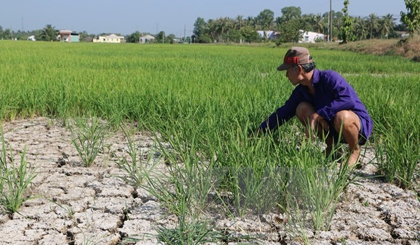Reducing damages caused by salt intrusion in the Mekong Delta
ABO/NDO - The Mekong River Basin is currently in the mid-dry season of 2017-2018. The Mekong Delta is strongly affected by two different tidal regimes in the East Sea and the West Sea.
 |
| A farmer on his dry rice field in the Mekong Delta province of Long An (Photo: VNA). |
During the tides, if winds (especially the East Sea wind) occur, they would increase the salinity intrusion on the main streams and canals. According to the meteorological and hydrography station in the South Western region, during the 2017-2018 dry season, the temperature in the delta will be the equivalent to the average of many years and is likely to be lower than the temperature of the same period last year. In the dry season, there is the possibility of unseasonal rain and the total rainfall is likely to be higher than the average of recent years. The aforementioned meteorological conditions will contribute to the reduction of evaporation, meeting the water demand for the crop. Salinity intrusion, however, can be severe in some localities
In the Mekong Delta provinces, water is used in a variety of industries but mostly serves rice cultivation. The area of paddies for the winter-spring crop in need of water in Long An province is 231,782 hectares; Tien Giang, 72,880 hectares; Ben Tre, 15,600 ha; Tra Vinh, 55,000 hectares; Dong Thap, 206,000 hectares, and Kien Giang, 290,050 hectares. Meanwhile, in the mouth of the Mekong River, from the beginning of the dry season, salinity has occurred, from 0.1-5.8g/l lower than that in the same period in 2017, and 4.6-19.5g/l lower than in 2016. In the West Coastal region and the Cai Lon River, the salinity is much higher than the same period of 2017. Thus, the depth of salinity intrusion in the Mekong Delta from the beginning of the dry season has an area of 32 to 55km.
In order to actively prevent and control the impact of salinisation on agricultural production, localities need to store fresh water at the highest level since fresh water appears in the river and prepare a plan for drought and salt intrusion prevention. The agricultural sector should have a plan for active production and a reasonable planting calendar. In some areas with difficult water sources or no works to combat saltiness, it is necessary to wait for rain such as in the summer-autumn crop. In the long term, localities in the Mekong Delta need to develop a strategy for supplying fresh water, as well as pay attention to upgrading fresh water transfer channels.
With both immediate and long-term solutions, the Mekong Delta provinces will gradually overcome the damages caused by droughts and saline intrusion in order to prevent a repeat of the situation in the 2016-2017 dry season when 11 of the 13 provinces and cities were forced to declare a state of disaster.
(Source: NDO)
 về đầu trang
về đầu trang







